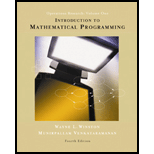
Explanation of Solution
Given:
Let
Objective function:
The processor 1 that runs for 1 hour requires 2 barrels of crude oil 1 and 3 barrels of crude oil 2 and the output of process 1 for one hour produces 2 barrels of gas 1 and 1 barrel of gas 2.
The processor 2 that runs for 1 hour requires 2 barrels of crude oil 1 and 3 barrels of crude oil 2 and the output of process 2 for one hour produces 3 barrels of gas 2.
The process 3 that runs for 1 hour requires 2 barrels of crude 2 and 2 barrels of gas 2 and the output of process 3 for one hour produces 2 barrels of gas 3.
The revenue from the gas 1 is sold for $9 and the revenue from gas 3 is sold for $24 is
Considering the constraints,
Constraint 1: Total oil 1 used in process 1 and 2.
Constraint 2: Total oil 2 used in process 1,2 and 3.
Constraint 3 and 4: Each week, 200 barrels of crude oil 1 and 300 barrels of crude oil 2 must be purchased.
Constraint 4: Production gas 2 will be equal to the gas 2 sold and gas 2 used in 3 that have been produced by process 1 and 2 by using the amount of gas 2 produced and from each process.
Constraint 6: Each week, 100 hours of time catalytic crackers are available.
Expressing the constraint 1 in terms of
Expressing the constraint 2 in terms of
Want to see the full answer?
Check out a sample textbook solution
Chapter 3 Solutions
Introduction to mathematical programming
 Operations Research : Applications and AlgorithmsComputer ScienceISBN:9780534380588Author:Wayne L. WinstonPublisher:Brooks Cole
Operations Research : Applications and AlgorithmsComputer ScienceISBN:9780534380588Author:Wayne L. WinstonPublisher:Brooks Cole
